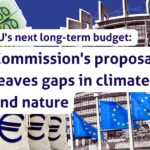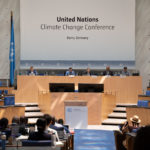Russia’s ongoing aggression in Ukraine is causing a major humanitarian crisis. On top of that, unfortunately the situation is proving, once more, how politically, socially and economically vulnerable Europe is due to its dependency on fossil fuels. Fossil fuels, their imports and subsidies come with an extreme cost not only for energy security, but for human rights, climate and social justice – a part of which is currently being paid by people’s lives.
Europe’s fossil fuel addiction is fueling Russia’s aggression in Ukraine right now, as well as other armed conflicts and authoritarian regimes in other parts of the world, where civilians have been and are being indiscriminately targeted. Moreover, increased gas prices have already had serious impacts on people living in Europe, with dire consequences for especially low-income people, and there are currently no safeguards against future price volatility due to the heavy role of fossil fuels in the energy mix. The EU is at a turning point for its energy transition and decisions taken these days will determine Europe’s energy security in the next few years, as well as the Union’s capability to deliver its commitment under the Paris agreement.
Different communications from the European Commission and Member States demonstrate that decision makers agree on the need for urgent action to change the current pattern, and to stop dependence on Russian energy supply. However, it is important to get the recipe for this change right in order to increase energy security, achieve our climate goals to prevent a worsening climate crisis while making sure that the people can fully take part in and benefit from the transition.
According to recent IPCC reports, there is still a window of opportunity to avoid the worst impacts of the climate crisis, but it is closing fast: effective adaptation to climate change is still possible only if greenhouse gas emissions drop drastically this decade. It is a now or never moment for the EU to prove its climate leadership at global level and get on the right energy transition track. To do so, the EU has two concrete occasions ahead:
1) Increasing the ambition of its climate and energy legislative proposals packed in the ‘Fit for 55’, with key legislative moments in May and June, and having energy savings and efficiency at the core of the accelerated energy transition needed;
2) Presenting an ambitious and detailed. ‘REPowerEU’ action plan in May which will provide strong leverage to get on the right energy transition track to ensure energy independence and delivery of the Paris agreement, clearly avoiding false solutions -such as LNG and pipe imports from other countries, and nuclear- justified as diversification of resources.
Bold climate and energy policy will allow the EU to break free from its fossil fuel shackles while protecting its people from polluting and volatile energy sources, doing no harm to countries outside the EU.
And how to align policy processes, legislative proposals and solid measures to the challenge ahead? We know the main, solid ingredient for this recipe is already available. CAN Europe’s Paris Agreement Compatible (PAC) scenario illustrates a pathway for the transition of the EU’s energy system that is in line with the commitment to limit the temperature rise to 1.5°C. We know that the EU can address the environmental and energy challenges through rapidly building an energy system that cuts greenhouse gas emissions by 65% in the year 2030. Taking concrete steps is more important now than ever. It is only a matter of will.
Below are 8 recommendations from CAN Europe to achieve an accelerated energy transition in the EU.
- Concrete plans to immediately phase out fossil fuels in a socially just manner must be adopted.
- The overall energy consumption must decrease considerably within this decade.
- Deep building renovations must start immediately.
- At least 4X the amount of installed solar and wind energy capacities must be added every year – compared to 2020.
- A rapid shift towards renewable heating systems must start with scaling up heat pumps.
- Flexibility options must be rolled out for the energy market.
- Energy and resource sufficiency targets must be included in industrial ecosystem transition pathways.
- All financial flows (public and private) must support the energy transition.



